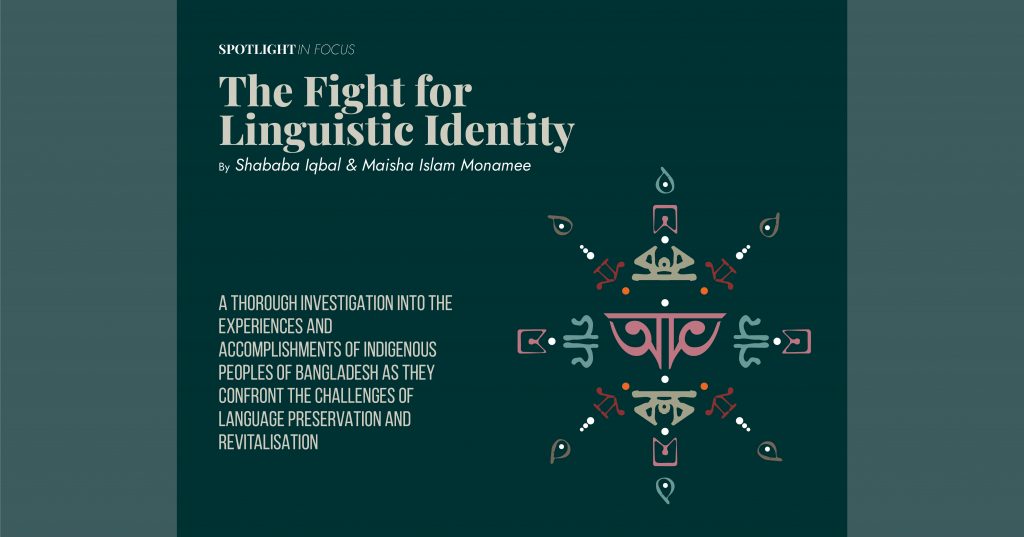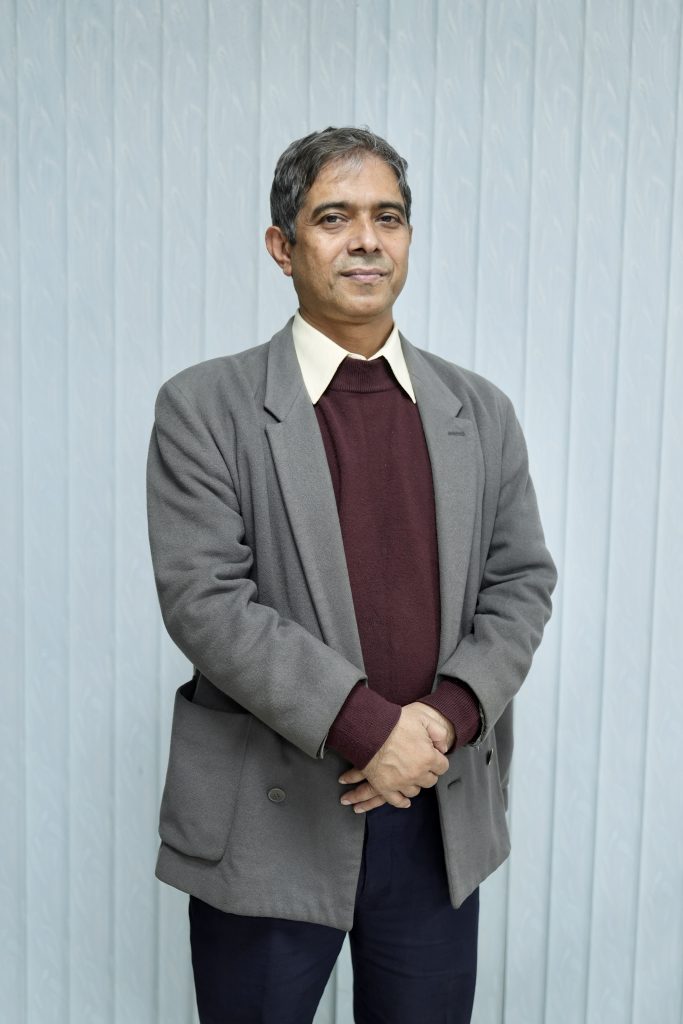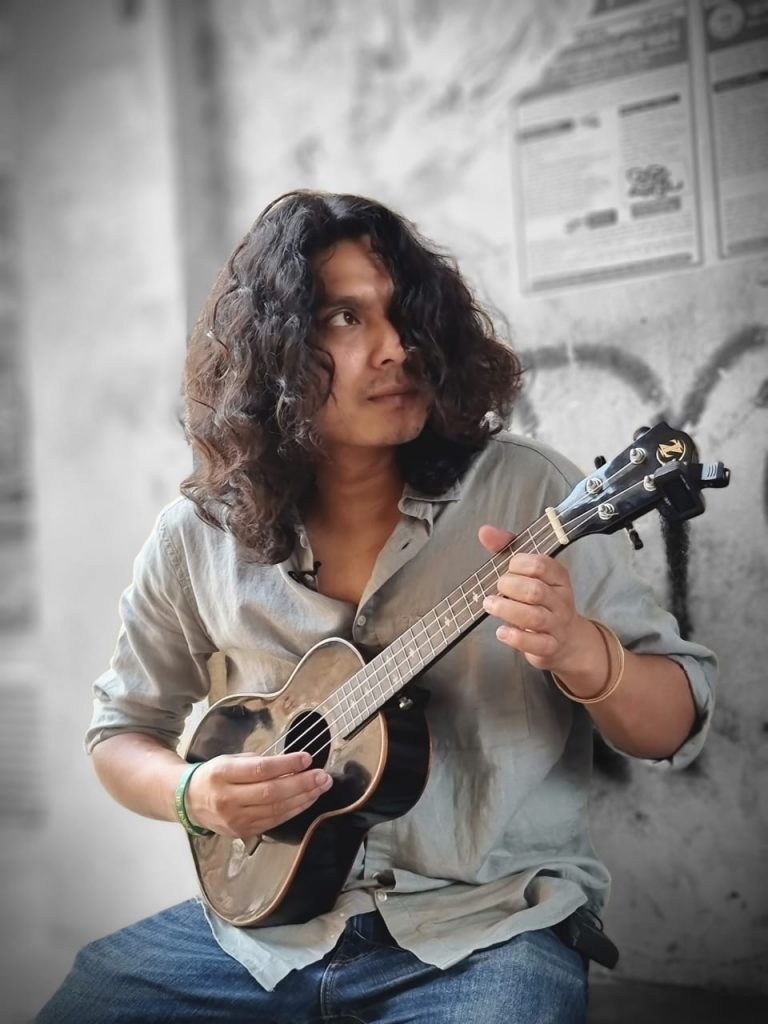
The only nation in the world to have fought for the right to speak in one’s own language, Bangladesh is better poised than any other country to comprehend the significance of a mother tongue. There are currently 42 languages spoken in the country, of which 36 are identified as indigenous. Of these, the languages spoken by the Chakma and Marma people have their own script, the Tripura use the Roman script, and most of the rest use the Bengali-Assamese alphabet. However, while these scripts exist, they are not widely learnt, or practiced, even by their native speakers. Dozens of indigenous languages in the country are gradually disappearing despite efforts to preserve them. The decline of the languages is aggravated by members of the communities moving away from their native tongues, as they need to learn Bangla and English to thrive in mainstream society.
The government provides primary school textbooks in Chakma, Marma, Tripura, Garo, and Sadri, as these languages have written forms that can be preserved. “Children belonging to these communities can take language courses in their mother tongues up until Grade Three. However, beyond that, they are taught in Bangla as other textbooks have yet to be translated into the indigenous languages. So, their proficiency in their own mother tongues is put at risk. Due to the lack of written records in the languages, there is a shortage of skilled teachers and researchers who are proficient in them,” says Professor Dr Hakim Arif, Director General of International Mother Language Institute.

PROFESSOR DR HAKIM ARIF. Photograph: Najmul Haque Sagor
Director General
International Mother Language Institute

ANIMES ROY
Musician

AUNG RAKHINE
Filmmaker
Currently residing in the USA, Turna Nishita Sinha from Moulvibazar and Showmik Singha from Sunamganj, struggle to balance Bishnupriya Manipuri, their mother tongue, with Bangla and English. Due to communication concerns, Turna’s parents taught her Bangla at home. She was bullied during her childhood, particularly for mispronouncing Bangla words. Showmik learned Bangla through his school and friends in Bangladesh, facing challenges in learning his mother tongue within the largely Bangla-centric education system. While Showmik was not explicitly pushed towards Bangla, his surrounding linguistic landscape naturally influenced his acquisition, but he makes it a point to entirely speak in his mother tongue during visits to his village. He observes a distinct ‘city shift,’ where Bishnupriya Manipuri is infused with Bangla, while rural areas retain a purer form. Both Turna and Showmik feel that Bishnupriya Manipuri’s preservation highly depends on active spoken use, which diminishes with migration as there are limited opportunities to converse in it. With that said, Turna emphasises that research projects by the Manipuri Lalitkala Academy and community writers offer hope for the language’s survival.
Kalmakanda upazila’s Basil Kubi, who belongs to the Garo community, shares that Bangla is slowly taking over his own mother tongue. At home, he speaks in the Abeng version of Garo language, mostly popular in northern Bangladesh with about 1.25 lakh speakers. “In my experience, our language is mainly passed down orally through generations. I feel a spiritual bond with my community when I communicate in my mother tongue, and it brings me immense pride,” he adds.
“Children belonging to these communities can take language courses in their mother tongues up until Grade Three. However, beyond that, they are taught in bangla as other textbooks have yet to be translated into the indigenous languages. So, their proficiency in their own mother tongues is put at risk.”
Originally from Rangamati, Sejuti Chakma’s linguistic journey spans from her childhood in Bangladesh to pursuing a second master’s degree in Germany. Growing up, she naturally acquired Bangla from her neighbourhood, while at school, she had no avenue for learning Chakma, her native tongue. Despite this obstacle, Sejuti’s family nurtured her heritage by ensuring that she learned it at home. But she belongs to a generation where fluency in Chakma is not complete, as neither she nor her parents can read or write it. While there are folktales and songs keeping Chakma alive as a language, the practical use of the Chakma alphabet is overshadowed by the prioritisation of learning Bangla and English. People within the Chakma community tend to use Bangla letters to write Chakma due to a lack of familiarity with their native script. Sejuti, however, sees hope in the recent efforts to teach children to read and write in Chakma, publish books on the Chakma alphabet, and promote Chakma literature.
Akiu Marma from Rangamati belongs to a family with Marma and Tanchangya roots. She speaks both languages, as well as Bangla. Through interactions with the children of her mother’s colleagues, Akiu was introduced to Bangla from an early age. The school system in her village, though Bangla-based, witnessed a vibrant use of native languages between students and teachers, showcasing impressive retention. Yet, urban life, she emphasises, presents a stark contrast, with most indigenous families prioritising Bangla. Akiu is the keyboardist of the all-girl indigenous band, F Minor. Along with Bangla, they perform songs in several other languages, such as Garo, Chakma, Marma, Tanchangya, Hajong, and Tripura among others.
Music and film, as creative mediums, can significantly contribute to the preservation and promotion of the diverse languages spoken in Bangladesh. By integrating lesser-known dialects into their work, artistes can help to shine a light on the challenges faced by these communities and aid in the documentation and preservation of these languages. In doing so, they play an important role in maintaining and revitalising the rich linguistic diversity of Bangladesh, thereby helping to safeguard its cultural heritage for future generations to appreciate and cherish.
Prior to Nasek Nasek, the song that kicked off the first season of Coke Studio Bangla, Hajong, as a language, was largely confined to the Hajong community in Bangladesh, with limited awareness outside their circles. The song’s immense popularity introduced it to millions of listeners across the country and beyond. The catchy tune and Animes Roy’s powerful vocals ensured that the song was not just heard, but also remembered and shared. This newfound exposure sparked curiosity and appreciation for the language, going beyond just the song itself.
Music and film, as creative mediums, can significantly contribute to the preservation and promotion of the diverse languages spoken in Bangladesh.
“Music serves as a natural carrier of oral traditions, passing down stories, poems, proverbs, and vocabulary through generations and aiding in the long-term retention of language elements. This is particularly crucial for Hajong, as it has no alphabet,” explains Animes. “I was highly encouraged by the acceptance that Nasek Nasek received. Music offers an engaging and enjoyable method for language learning, especially for children. As a Hajong singer-songwriter, I aspire to contribute to this process.”
Though educated in Bangla, Aung Rakhine, an indigenous filmmaker, endeavoured to read and write in his native tongue, Rakhine, in his own time. Despite his efforts, he gradually lost touch with the language over the years. In 2012, he ventured into filmmaking, and his debut feature, Mor Thengari or My Bicycle (2015), marked Bangladesh’s first Chakma language film.
“I aim to shine a light on the realities and perspectives that might otherwise go unnoticed, contributing to a richer and more diverse cinematic landscape.”
The poignant narrative delves into the life of a Chakma family, their village, and the impact of modernity on their simple existence. Aung’s dedication transcended borders, earning him accolades such as the Best Screenplay at the Silver Azkubat Ethnic Cinema Festival 2016 in Ufa, Russia, and an honourable mention at the Cine Kurumin – International Indigenous Film Festival 2016 in Brazil. “Cinema, to me, is a powerful medium that connects indigenous communities with international audiences, bringing their stories and experiences to the forefront. My political beliefs often find expression in my work, as I believe it’s essential to explore important topics freely, without the constraints of self-censorship, which can inhibit artistic expression,” he says. “I aim to shine a light on the realities and perspectives that might otherwise go unnoticed, contributing to a richer and more diverse cinematic landscape.” Currently, Aung is working on a film about the Mro community, while gearing up for a personal project – a film inspired by his Rakhine roots and his father’s life.
The fight for linguistic identity is far from over in Bangladesh. Indigenous communities grapple with the pressures of assimilation, yet their cultural resilience shines through in many instances. By utilising creative mediums, fostering language education, and empowering communities, Bangladesh can not only safeguard its linguistic diversity but also reclaim a vital part of its heritage. This revitalisation holds the key to ensuring that future generations have the opportunity to connect with their roots and celebrate the unique languages that define their nation.
